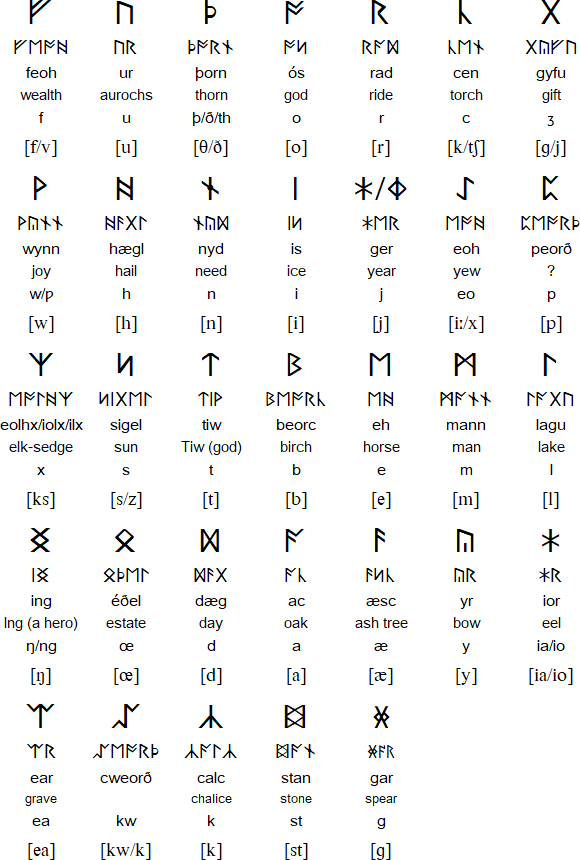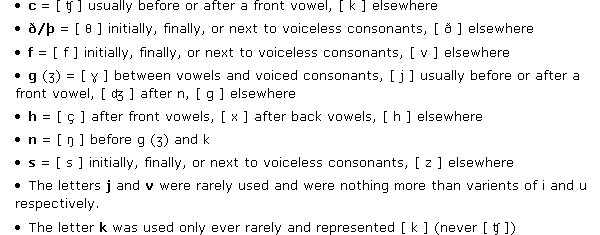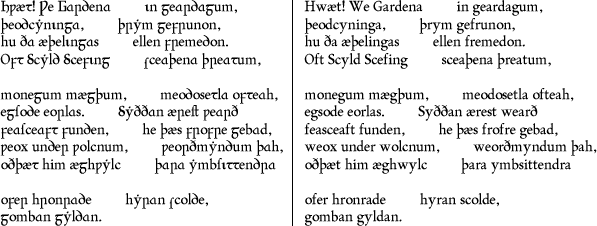Old English / Anglo-Saxon (Englisc)
Old English was the West Germanic language spoken in the area now known as
England between the 5th and 11th centuries. Speakers of Old English called their
language Englisc, themselves Angle, Angelcynn or
Angelfolc and their home Angelcynn or Englaland.
Old English began to appear in writing during the early 8th century. Most
texts were written in West Saxon, one of the four main dialects. The other
dialects were Mercian, Northumbrian and Kentish.
The Anglo-Saxons adopted the styles of script used by Irish missionaries,
such as Insular half-uncial, which was used for books in Latin. A less
formal version of minuscule was used for to write both Latin and Old
English. From the 10th century Anglo-Saxon scribes began to
use Caroline Minuscule for Latin while continuing to write Old English
in Insular minuscule. Thereafter Old English script was increasingly influenced
by Caroline Minuscule even though it retained a number of distinctive
Insular letter-forms.
Anglo-Saxon Futhorc
Old English / Anglo-Saxon was sometimes written with a version of the Runic
alphabet, brought to Britain by the Anglo-Saxons until about the 11th century.
Runic inscriptions are mostly found on jewellery, weapons, stones and
other objects. Very few examples of Runic writing on manuscripts have
survived.

Old English alphabet

Notes
- Long vowels were marked with macrons. These were not written
originally used in Old English but are a more modern invention
to distinguish between long and short vowels. - The alternate forms of g and w (yogh and wynn/wen respectively) were
based on the letters used at the time of writing Old English. Today they
can be substituted for g and w in modern writing of Old English. - Yogh originated from an insular form of g and wynn/wen came from a
runic letter and was used to represent the non-Latin sound of [ w ].
The letters g and w were introduced later by French scribes. Yogh came
to represent [ ç ] or [ x ].
Old English pronunciation

Notes

Sample text in Old English (Prologue from Beowulf)

Modern English version
LO, praise of the prowess of people-kings
of spear-armed Danes, in days long sped,
we have heard, and what honor the athelings won!
Oft Scyld the Scefing from squadroned foes,
from many a tribe, the mead-bench tore,
awing the earls. Since erst he lay
friendless, a foundling, fate repaid him:
for he waxed under welkin, in wealth he throve,
till before him the folk, both far and near,
who house by the whale-path, heard his mandate,
gave him gifts:
Most of the information on this page was provided by Niall Killoran
![]()
Old English / Anglo-Saxon language courses, dictionaries and other books
Links
The Electronic Introduction to Old English
http://www.wmich.edu/medieval/resources/IOE/
Learn Old English – a basic introduction
http://www.jebbo.co.uk/learn-oe/contents.htm
Ða Engliscan Gesiðas – the society for people interested in all aspects
of Anglo-Saxon language and culture:
http://tha-engliscan-gesithas.org.uk/
Old English dictionaries
http://home.comcast.net/~modean52/oeme_dictionaries.htm
http://lexicon.ff.cuni.cz/app/
Beowulf in Hypertext
http://www.humanities.mcmaster.ca/~beowulf/
ALPHABETUM – a Unicode font
specifically designed for ancient scripts, including classical
& medieval Latin, ancient Greek, Etruscan, Oscan, Umbrian,
Faliscan, Messapic, Picene, Iberian, Celtiberian, Gothic, Runic,
Old & Middle English, Hebrew, Sanskrit, Old Nordic, Ogham,
Kharosthi, Glagolitic, Old Cyrillic, Phoenician, Avestan, Ugaritic,
Linear B, Anatolian scripts, Coptic, Cypriot, Brahmi, Old Persian cuneiform:
http://guindo.pntic.mec.es/~jmag0042/alphabet.html
